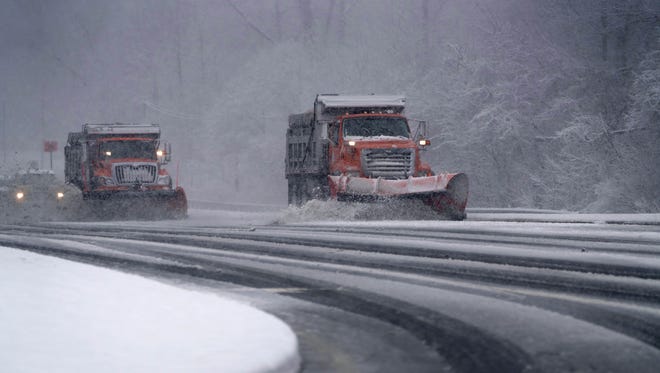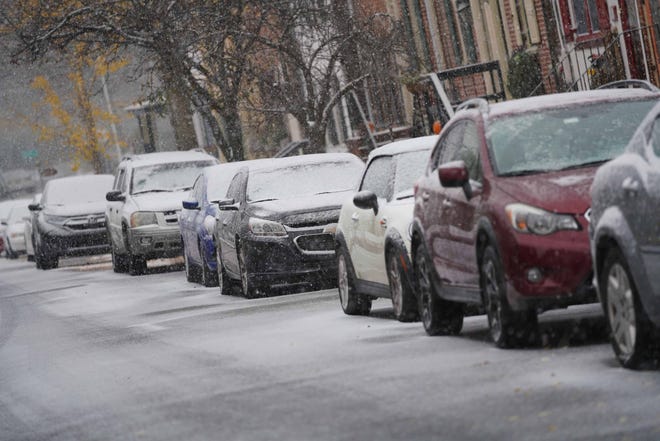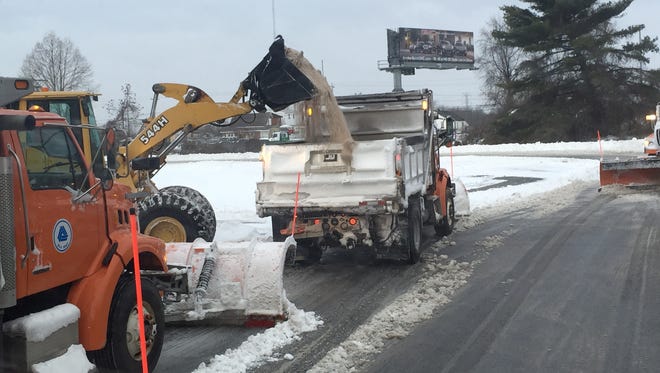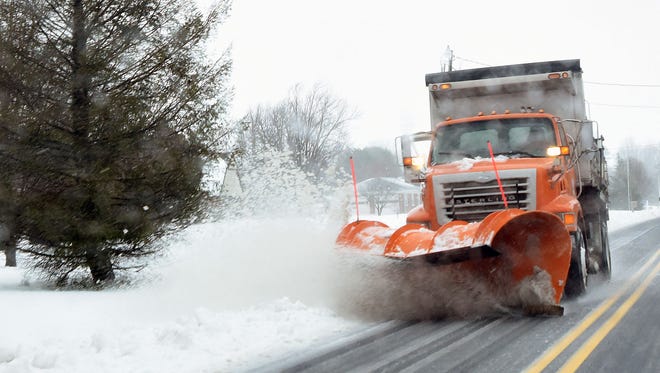Free: This story is being provided free to all readers as a public service by Delaware Online/The News Journal. Please consider supporting local journalism by subscribing.
This story was originally published on Nov. 15, 2018.
Whenever snow falls in Delaware, motorists inevitably wonder what the Delaware Department of Transportation is doing to get the roads clear again.
Luckily, DelDOT has the answers to all your questions.
Here’s a full rundown on what the state does when it snows, taken from the department’s FAQ page. You can also find the following information online at deldot.gov.

Who decides when to send out snowplows?
A: The decision to begin deploying snowplows is made after forecasts are studied and estimates are made as to storm severity and duration, as well as the expected personnel and equipment resources required to do the job.
Photos:Delaware’s first snow storm of 2022
Say it ain’t snow:More winter weather on the way to Delaware Thursday night into Friday
‘It’s pretty if you can stay inside’:Delaware digs out from ‘incredible amount’ of snow
My vehicle is stuck in the snow – what do I do?
A: Should your vehicle become stuck in the snow, you can contact the local emergency operations center for assistance.
- Sussex County: 302-855-7801
- Kent County: 302-735-3474
- New Castle County: 302-395-2700
- Wilmington: 302-576-3914
However, given the severity of a storm, an immediate response is not guaranteed and you should always keep an emergency travel kit in your car.

How much snow has to fall before DelDOT plows?
A: DelDOT does not decide to begin plowing based on the amount of snow on the roads. The decision is made based on a variety of predictive and observed factors, including pre-treatment efforts, weather forecasts, field reports of changing weather conditions in different areas of the state and resources required for the event.
How does DelDOT decide which roads to plow first?
A: DelDOT assigns priority levels to each road, taking into account the amount of traffic it typically carries, population density in the surrounding areas and how crucial it is to the functioning of the overall road system.
Roads are typically assigned to one of three major categories:
Primary Roads, also known as Arterial Routes and/or Expressways
Definition: Multi-lane highways, and some two-lane roads designed to carry heavy traffic volumes between major destinations. Examples:
- New Castle County, Interstate 95, SR 1, Route 13, Route 40,
- Kent County, SR 1, Route 13
- Sussex County, SR 1, Route 13, Route 404
- All public transit routes throughout the state are also considered primary routes. This provides citizens with alternatives to driving during snow and ice storms.
Secondary Roads, also known as Collector Routes
Definition: These roads receive less traffic than primary roads, but are the main feeder routes to the primary roads. Examples:
- New Castle County, Route 9, from Odessa to Bear, Route 71, Red Lion Road.
- Kent County, Hazlettville Road.
- Sussex County, Cave Neck Road, Route 24, John Williams Highway.
Local Roads
Definition: Roads that are used to travel to and from less densely populated residential or agricultural areas, used primarily by those who live along them.
These roads frequently have three-number designations.
How many miles of road does DelDOT plow?
A: DelDOT maintains nearly 14,000 lane miles of roadway across the state.
How many pieces of snow removal equipment does DelDOT have?
A: DelDOT has more than 400 pieces of snow removal equipment statewide including plows, loaders, and motorgraders.
Why doesn’t DelDOT plow some streets?
A: While DelDOT is responsible for the maintenance of nearly 90 percent of roads in the state, the agency does not plow roads and streets that are maintained by towns or cities or in privately maintained subdivisions.

What should I do when driving next to a snow plow?
A: Snowplows are on the road for your safety. When you encounter a snowplow, remember:
- Don’t crowd the plow.
- Plow drivers have limited visibility so don’t assume your vehicle is in view.
- Maintain a safe distance behind the snowplow – at least five car lengths.
- Plows aren’t just removing snow. They may also be spreading salt or brining roadways.
- Be patient — slow down, plows are large and move slower than highway speeds when plowing.
Where does DelDOT get its weather information?
A: Primarily, DelDOT utilizes weather forecasts and other weather-related information from the National Weather Service. They provide official forecasts as well as weather updates throughout snow events to DelDOT’s snow removal teams and officials at the Delaware Emergency Management Agency.
How and where does DelDOT measure snowfall?
A: DelDOT has 26 measuring stations throughout the state to record official snowfall. These stations are managed by the University of Delaware.
The National Weather Service also has snow measuring stations in Delaware.
What is a snow emergency and what should I do if one is declared?
A: Technically, Delaware does not declare snow emergencies. However, the state has a three-level system of driving warnings and restrictions.
Level 1 — Driving Warning: Drivers are discouraged from operating a motor vehicle on the state’s roadways unless there is a significant safety, health or business reason to do so.
Level 2 — Driving Restriction: Travel on the roads is restricted to emergency workers, public utilities, healthcare providers including hospital staff, public and private operators of snow removal equipment, private sector food and fuel deliveries, and those industries, companies or organizations that have been provided a waiver, including businesses with pressing continuity and operational issues.
Level 3 — Driving Ban: Complete ban on driving except for first responders, utility personnel, and public or private snow removal. Businesses and organizations should adjust work schedules so that employees do not need to be on the roads during a Level 3 Driving Ban.

Who should I call if I have an emergency and I’m snowed in?
A: If there is an emergency that is life threatening, call 911. However, if you have a non-life-threatening emergency and you need to travel by automobile you may request assistance by calling your county’s Emergency Operations Center:
- Sussex County: 302-855-7801
- Kent County: 302-735-3474
- New Castle County: 302-395-2700
- Wilmington: 302-576-3914
Why can’t DelDOT prevent ice from forming overnight and keep snow from drifting back onto roads?
A: When temperatures fall below 20 degrees Fahrenheit, or when snow is accumulating rapidly, snow-melting materials are less effective and plowing becomes the primary means of keeping roads passable.
Although busy intersections and other potential trouble spots are attended to, often repeatedly, traffic moving back and forth through these busy areas pack the snow and ice onto the road making removal much more difficult.

How does DelDOT decide whether to pre-treat roads?
A: DelDOT’s goal is to pre-treat primary roads with brine before snow or ice has a chance to accumulate. This causes the initial coating of snow and ice to melt and slows down or may even stop the accumulation of ice and snow on the road surface. Brine also serves as a bond breaker which helps for clearing the road.
There are several factors that determine whether DelDOT pre-treats roadways ahead of a storm:
- DelDOT will not brine roads if the precipitation is predicted to begin as rain as this will wash the liquid salt solution off the roads and be ineffective.
- If DelDOT has brined or salted roadways in the previous days and conditions have been dry, further pre-treatment may also be deemed unnecessary due to the residual salt on the roadways.
- If pavement temperatures are forecasted to be above freezing, DelDOT may not brine in advance of a storm.
- Depending on the severity of the storm that is forecasted, the air temperatures and pavement temperatures DelDOT may begin pre-treating roads as early as three days before an expected event.
What does DelDOT pre-treat roads with?
A: Typically, DelDOT uses a salt and water mixture called brine for pre-treating. Unlike straight salt, brine adheres to the road better, and will not be blown away by traffic or high winds.
As the snow begins to fall and accumulate, and throughout a snow event, road salt is used because the salt will adhere to the snow and ice and facilitate melting.
Why do plows drive so fast?
A: DelDOT is responsible for nearly 14,000 lane miles of road in the state, and snow removal operations must proceed as quickly and safely as possible to restore safe driving conditions. In addition, drivers must maintain a sufficient speed to ensure that the plowed snow is pushed off the road. Drivers are trained to operate their equipment at safe speeds that will result in an effective snow removal effort over a large area.
If you feel a vehicle is being driven in a reckless or unsafe manner, please contact DelDOT’s Transportation Management Center at 302-659-4600 or #77 with detailed information about the situation.

Why is that snowplow parked on the side of the road or a local business?
A: DelDOT crews work long hours during storm events, and sometimes take their meal breaks at local businesses.
Plows are sometimes pre-positioned to areas around the state before a storm begins so that they can begin plowing and treating roads as soon as precipitation begins.
Why do some trucks ride with their plows up?
A: Trucks are assigned to plow specific roads, and they must travel quickly, but safely, over a primary or other road to get to the next assigned area. With their plows down, trucks move more slowly and may need to stop at each crossroad. In addition, if a road has been recently salted, driving with the plow down may remove the salt that has been applied to help melt the snow or ice.
How much money does DelDOT spend on snow removal?
A: Since each winter and each winter storm is different, it is hard to say how much DelDOT spends on snow removal. DelDOT budgets $10 million dollars for snow removal each fiscal year but the amount spent varies.

A plow hit my mailbox. What do I do?
A: DelDOT takes every reasonable precaution to minimize or prevent any damage to public or private property during any of its operations.
However, if your property was damaged, please call the Delaware insurance coverage office at 877-277-4185 or email the Delaware Insurance Coverage Office at InsCov@state.de.us.
What can I do to help with snow removal?
A: The best way to assist in snow removal operations is to prepare well in advance for winter storms. By stocking up on items you and your family might need, and making other necessary arrangements with employers, family and friends, you should be able to stay safe and warm rather than be on roads exposed to potential hazards.
Keeping roads clear of traffic, reducing the incidence of stranded or stuck vehicles, and minimizing the need for emergency responders, helps DelDOT’s snow removal teams do their jobs more thoroughly, efficiently and safely.
Contact Jessica Bies at (302) 324-2881 or jbies@delawareonline.com. Follow her on Twitter @jessicajbies.